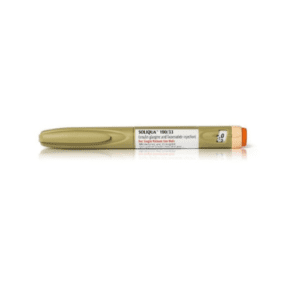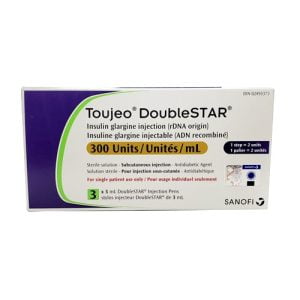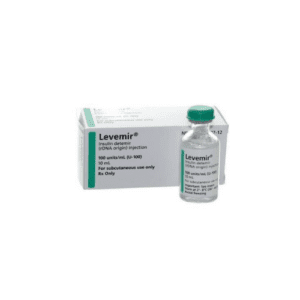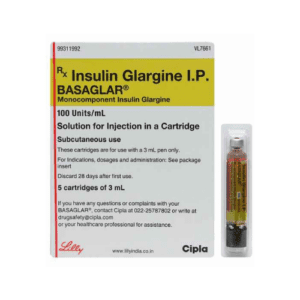Description
People living with diabetes require proper understanding and management of their condition. One aspect that needs adequate comprehension is the use of insulin therapies like Lantus. In this Lantus review, we will delve into the specifics of Lantus, also known as insulin glargine, shedding light on its efficiency, uses, and potential side effects.
What is Lantus (Insulin glargine)?
Insulin glargine, sold under the Lantus brand, is a long-acting insulin used to treat both type 1 and type 2 diabetes. It operates by lowering the levels of glucose (sugar) in the blood. Unlike short-acting insulins, Lantus works steadily and lasts longer, often up to 24 hours. This slow and steady release of insulin aids in managing blood sugar levels efficiently throughout the day.
Insulin glargine is typically administered via an injection under the skin. It’s crucial to remember that its dosage is not the same for everyone and is dependent on numerous factors like body weight, diet, activity levels, and the severity of the disease. Patients should be guided by healthcare professionals when determining the right dosage.
Drug Facts
Lantus, or insulin glargine, is a type of long-acting insulin that is used in the treatment of diabetes. This medication is designed to lower the levels of glucose in the blood by simulating the effects of natural insulin. Many diabetes patients may also know Lantus by other names such as Basaglar, Semglee, or Toujeo. These different names can sometimes confuse us, but they all refer to this key drug in our fight against diabetes.
Understanding how Lantus works is crucial for patients and caregivers alike who need to manage diabetes treatment plans. This medication operates by replenishing the insulin that our bodies naturally produce, helping to control the levels of glucose in the blood.
How Insulin glargine (Lantus) works
Insulin is a hormone that the body naturally produces to help regulate sugar, or glucose, in the blood. When a person has diabetes, the body either does not produce enough insulin or does not use insulin effectively. This is where Lantus comes in. Its specialized formula is designed to provide continuous, steady insulin levels over 24 hours.
Lantus is part of the Lantus drug class known as long-acting insulins. It is a synthetic form of insulin that starts to work several hours after injection and keeps working evenly for 24 hours. It effectively replaces your body’s natural insulin production, providing a stable level of insulin to help control the amount of glucose in your blood.
What is Insulin glargine (Lantus) used for?
Lantus functions primarily by stimulating glucose uptake in the body cells and inhibiting the production of glucose in the liver. Unlike other types of insulin, it’s designed to be absorbed slowly over 24 hours providing a constant yet low level of insulin to maintain a steady blood sugar level throughout the day. Dosage generally varies depending on the patient’s blood sugar levels, and it’s usually administered once daily, subcutaneously. However, always consult a healthcare professional for accurate dosage information.
Low blood sugar (hypoglycemia)
Lantus, also known as insulin glargine, is a long-acting insulin that helps people with diabetes control their blood sugar levels. Manufactured by Sanofi, this prescription medication is often used by those with Type 1 and Type 2 diabetes to supplement naturally occurring insulin, regulate a steady insulin level, and hence lower blood sugar. Throughout this Lantus Review 9, we will take a closer look at the various effects and side effects of this widespread insulin therapy.
Swelling and Heart Failure
Lantus (insulin glargine), a long-acting insulin analog, is known for its steadier and smoother effect compared to other insulins. However, like any medication, it can cause side effects. One of the potential side effects, though less common, is fluid retention leading to swelling, a condition that may worsen or trigger heart failure in some patients.
Severe Allergic Reactions
In case of hypoglycemia or low blood sugar, which is characterized by trembling, excessive sweating, and dizziness, it is necessary to consume items that are high in sugar at first sign of these symptoms. It is also useful to carry glucose tablets or gels with you. However, these are not a long-term solution to ongoing episodes of hypoglycemia. A consultation with a healthcare provider is needed to adjust the medication to appropriate levels.
Insulin glargine (Lantus) dosage forms
This medication typically comes as a clear, colorless solution that is administered subcutaneously. It comes in two primary forms, a single-patient-use prefilled SoloStar pen and a 10 mL vial. Each milliliter of the Lantus solution has 100 units (U-100) of insulin glargine.
Interactions between Insulin glargine (Lantus) and other drugs
When considering the interactions, it is essential to understand that many drugs can affect the way insulin works in the body. Other diabetes medications, including other insulins, oral antidiabetes drugs, and certain injectable medications, might intensify the hypoglycemic effect of Lantus, increasing the risk of low blood sugar.
Insulin glargine (Lantus) contraindications
It is also worth knowing that several factors can affect blood sugar levels and consequently, the dose of Lantus needed. These include diet, physical activity, illness, stress, other medications, and alcohol consumption. Therefore, regular monitoring of blood glucose levels is crucial for managing diabetes effectively.
In terms of insulin dosage, it is essential to adhere strictly to the prescribed dosage and not to make changes without consulting a healthcare professional. It’s also important to inform your doctor of any other medications you might be taking as these could affect the action of insulin in your body.
Insulin glargine (Lantus) images
Consistent with other insulin brands, Insulin glargine (Lantus) is to be administered subcutaneously, and accurate dosing is determined by the individual’s existing insulin needs and blood sugar level. The high repeatability level of Lantus is indeed commendable, providing a consistent profile and reduction in the risk of nocturnal hypoglycemia. As for side effects, these are similar to other insulins, with the potential for hypoglycemia, weight gain, allergic reactions, and injection site reactions.
Total Daily Insulin Requirement:
The general calculation for the body’s daily insulin requirement is:
Total Daily Insulin Requirement (in units of insulin)
= Weight in Pounds ÷ 4
Alternatively, if you measure your body weight in kilograms:
Total Daily Insulin Requirement (in units of insulin)
= 0.55 X Total Weight in Kilograms
Example 1:
If you are measuring your body weight in pounds:
- Assume you weigh 160 lbs.
In this example:
TOTAL DAILY INSULIN DOSE
= 160 lb ÷ 4 = 40 units of insulin/day
Example 2:
If you are measuring your body weight in kilograms:
- Assume your weight is 70Kg
In this example:
TOTAL DAILY INSULIN DOSE
= 0.55 x 70 Kg = 38.5 units of insulin/day
If your body is very resistant to insulin, you may require a higher dose. If your body is sensitive to insulin, you may require a lower insulin dose.






Reviews
There are no reviews yet.